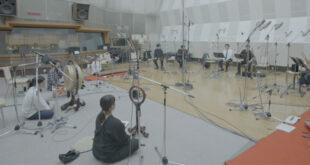Facial motion capture is typically the realm of triple-A projects.
Indeed it has been contributions to a wealth of high profile titles including Grand Theft Auto V, Halo: Reach and Sleeping Dogs on which Faceware has built its reputation, offering tools, hardware and workflows designed to empower the artist.
However, March saw Faceware unveil a new range of packages now available to – and tailoured for – indie and mobile studios. The full Faceware Indie Facial Mo-cap Package combines hardware and tools, including camera and headmount, and is also available in various combinations.
Develop caught up with Faceware to find out more.
Why did Faceware feel there was an opportunity with mobile and indie teams, in terms of facial animation technology? Was it a response to a particular trend?
Peter Busch, VP of business development, Faceware: It’s not a secret there is a massive shift in overall gaming from many triple-A developers to more mobile and indie development. We have noticed at the last few GDCs an overwhelming amount of indie and mobile developers coming to our booth and exhibiting on the floor.
Plus, with emerging markets in Asia and South America, this has even further bolstered the indie market. We felt offering solutions that are easy-to-adopt at a low price point will aim directly at the growing quality demands in this space.
And what does this new package offer such teams?
Busch: The Indie Facial Mo-cap Package offers teams a complete turnkey hardware and software facial motion capture solution. This will give even the greenest of developers the ability to fit facial performance capture into their development cycle.
Clearly Faceware has long offered a high-end product, but at the same time, being markerless and such, at the developer end there’s a simplicity to what you provide. Have you managed to streamline that simplicity any more in terms of those studios new to capture technology and methods?
Busch: Yes. New technology that we released last year took a lot of the guesswork out of the process of producing solid results. We’ve standardised the method to get a good baseline out of our software – allowing new users to get up to speed quickly. Plus, by offering ‘Lite’ and ‘Pro’ solutions, studios can start with a simplified, strong product, and slowly integrate into the more advanced Pro features. It was important to us that the Lite versions contain our most powerful and exclusive technology for all of our end users.
So how significant are those differences between your Lite and Pro technologies?
Busch: It is fairly significant. The Lite version gives single artists and indie teams all of the tools they need to produce an animated result from video. It is quick, efficient, and contains some exclusive, industry-leading technology. The Pro versions of our software are aimed at larger teams of artists and studios wanting higher quality, higher production value.
The Pro version simply allows for increased accuracy in our tracking software, increased quality control and refinement in our animation software, as well as the ability to script anything, share data amongst a team, and floating licenses.
Even with your package of hardware and middleware tailored for smaller teams, indies still might be a little intimidated by the idea of embracing facial capture technology, such is its association with triple-A. What else has Faceware done or what can you do in terms of service to smooth the process for indie teams?
Busch: We love case studies and showing users content to make them more comfortable in their adjustment using to facial capture.
The integration of new technology and tools is always a risk for developers. Our hope is that through education we can help the community embrace our selection of tools and make them a mainstay in their workflow.
And how is the integration with other indie-friendly and mobile-friendly engines and middleware?
Busch: It’s quite easy. Our tools are already fully integrated with Autodesk products, so the process of creating facial animation is much like any animation they might be producing by hand or procedurally. Autodesk and the middleware engine developers have many tools to export this data into
engine-ready assets.
In working with Indie developer Camouflaj on République, they found our workflow intuitive and easy, and were able to get animation running in Unity within a few days.
What do you see as being the potential impact of the Indie Facial Mo-cap Package on the end product indies and mobile teams are making?
Busch: With Republique, you can now see the triple-A quality available to indie developers. This will change the indie and mobile development market as the quality bar is higher and the possibilities for advanced storytelling are real.
With hardware always improving, the focus on gameplay and experience will only increase as well. We see a trend of indie developers wanting to match the quality of Grand Theft Auto V or Batman: Arkham City. With Faceware’s Indie Facial Mo-cap Package, they have the opportunity to do so, with a simple, surprising low-cost licence.
And on that note, what are the pricing options available?
Busch: Developers should look at our Indie Facial Mo-cap Bundle – giving them a GoPro Headcam Kit and ‘Lite’ licences of our Analyzer and Retargeter software for $2,995 plus $238 per year. Developers wanting to use their own cameras can use the Lite versions of our software starting at just $395.
You’ve also launched two new elements to your Professional Product Line in the Pro HD Headcam and Faceware Analyzer Pro. Why should developers take notice?
Busch: The Pro HD Headcam is amazing – a higher framerate, higher resolution camera. The benefit of working with video-based facial motion capture technology is that you always have great video reference. With the Pro HD Headcam, devs now have HD-quality, crystal clear video as well as a higher framerate for improved quality of motion.
With something as complex as the face, the higher framerate allows better movement capture from our software. This is something that has long been a driving factor of quality body mo-cap, and now we’re including this in our professional facial capture product line.
The latest version of Analyzer Pro is exciting. For the first time users do not have to exclusively use the data from Analyzer in Retargeter. By allowing X and Y values of our landmark tracking points to be exported on every frame of video, there are limitless possibilities for developers to take advantage of our sleek, intuitive Analyzer Product in new ways
Developers have already starting using this new data type for 4D scan retopologisiation, shader development, as well as a quality control tool to ensure tracking accuracy prior to retargeting.

 MCV/DEVELOP News, events, research and jobs from the games industry
MCV/DEVELOP News, events, research and jobs from the games industry



